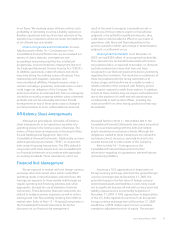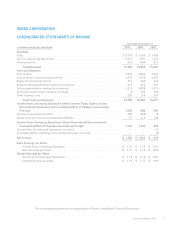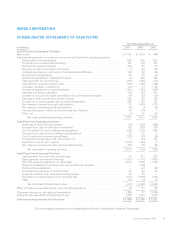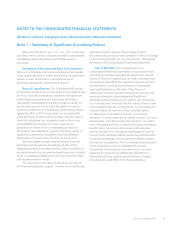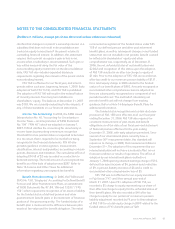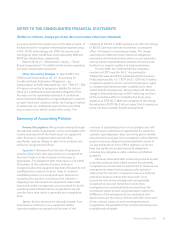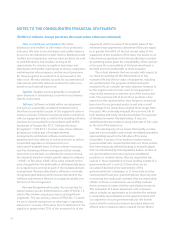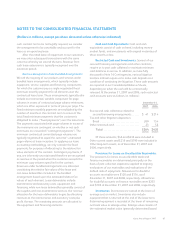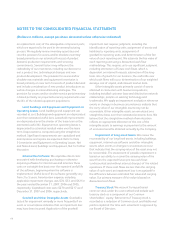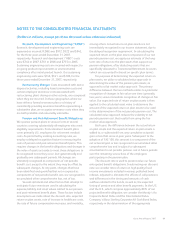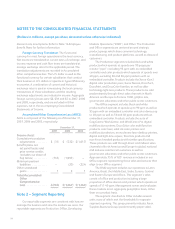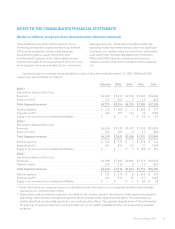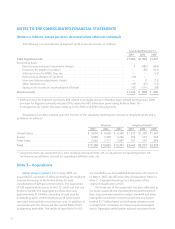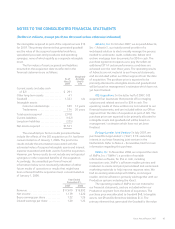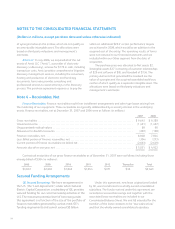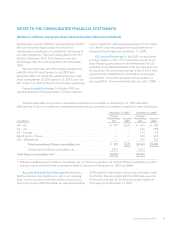Xerox 2007 Annual Report Download - page 87
Download and view the complete annual report
Please find page 87 of the 2007 Xerox annual report below. You can navigate through the pages in the report by either clicking on the pages listed below, or by using the keyword search tool below to find specific information within the annual report.NOTES TO THE CONSOLIDATED FINANCIAL STATEMENTS
(Dollars in millions, except per-share data and unless otherwise indicated)
price was equal to the market price at the date of grant. If
we had elected to recognize compensation expense using
a FAS 123(R) methodology our 2005 net income and
earnings per share would have been reduced by $88 and
$0.09 per diluted share, respectively.
Refer to Note 17 – Shareholders’ Equity – “Stock-
Based Compensation” for additional disclosures regarding
our stock compensation programs.
Other Accounting Changes: In March 2005, the
FASB issued Interpretation No. 47, “Accounting for
Conditional Asset Retirement Obligations – an
interpretation of FASB Statement No. 143” (“FIN 47”). FIN
47 requires an entity to recognize a liability for the fair
value of a conditional asset retirement obligation if the
fair value can be reasonably estimated. A conditional
asset retirement obligation is a legal obligation to perform
an asset retirement activity in which the timing or method
of settlement are conditional upon a future event that
may or may not be within control of the entity. The
adoption of FIN 47 in 2005 resulted in an after-tax charge
of $8 ($12 pre-tax) and was recorded as a cumulative
effect of change in accounting principle. This charge
represented conditional asset retirement obligations
associated with leased facilities where we are required to
remove certain leasehold improvements and restore the
facility to its original condition at lease termination.
In June 2006, the FASB ratified the consensus
reached on EITF Issue No. 06-2, “Accounting for
Sabbatical Leave and Other Similar Benefits Pursuant to
FASB Statement No. 43” (“EITF 06-2”). EITF 06-2 clarifies
recognition guidance on the accrual of employees’ rights
to compensated absences under a sabbatical or other
similar benefit arrangement. We recorded a $7 after-tax
charge to Retained earnings in 2007 reflecting our share
of the cumulative effect recorded by Fuji Xerox upon
adoption of EITF 06-2. With the exception of this charge,
the adoption of EITF 06-2 did not impact the Company as
we do not have a similar benefit arrangement.
Summary of Accounting Policies:
Revenue Recognition: We generate revenue through
the sale and rental of equipment, service and supplies and
income associated with the financing of our equipment
sales. Revenue is recognized when earned. More
specifically, revenue related to sales of our products and
services is recognized as follows:
Equipment: Revenues from the sale of equipment,
including those from sales-type leases, are recognized at
the time of sale or at the inception of the lease, as
appropriate. For equipment sales that require us to install
the product at the customer location, revenue is
recognized when the equipment has been delivered to and
installed at the customer location. Sales of customer
installable products are recognized upon shipment or
receipt by the customer according to the customer’s
shipping terms. Revenues from equipment under other
leases and similar arrangements are accounted for by the
operating lease method and are recognized as earned
over the lease term, which is generally on a straight-line
basis.
Service: Service revenues are derived primarily from
maintenance contracts on our equipment sold to
customers and are recognized over the term of the
contracts. A substantial portion of our products are sold
with full service maintenance agreements for which the
customer typically pays a base service fee plus a variable
amount based on usage. As a consequence, other than the
product warranty obligations associated with certain of
our low end products in the Office segment, we do not
have any significant product warranty obligations,
including any obligations under customer satisfaction
programs.
Revenues associated with outsourcing services as well
as professional and value-added services are generally
recognized as such services are performed. In those service
arrangements where final acceptance of a system or
solution by the customer is required, revenue is deferred
until all acceptance criteria have been met. Costs
associated with service arrangements are generally
recognized as incurred. Initial direct costs of an
arrangement are capitalized and amortized over the
contractual service period. Long-lived assets used in the
fulfillment of the arrangements are capitalized and
depreciated over the shorter of their useful life or the term
of the contract. Losses on service arrangements are
recognized in the period that the contractual loss becomes
probable and estimable.
Xerox Annual Report 2007 85


